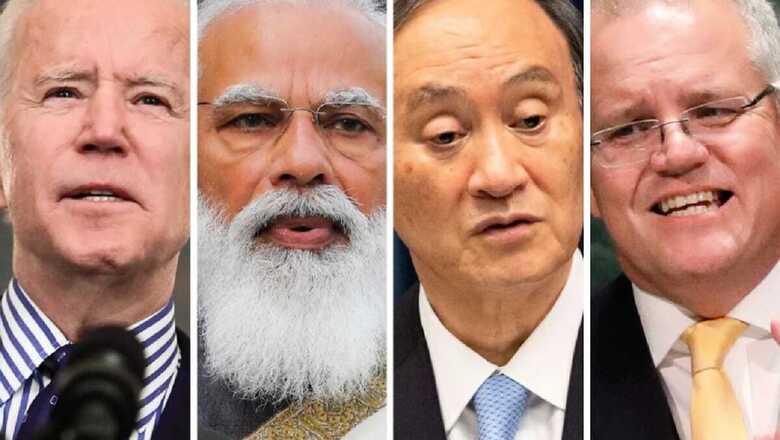
views
The joint statement adopted by leaders of the Quadrilateral framework, or Quad, consequent to their first summit-level meeting on March 12, 2021, read (excerpts) – “We strive for a region that is free, open, inclusive, healthy, anchored by democratic values, and unconstrained by coercion… We pledge to strengthen our cooperation on the defining challenges of our time… We commit to work together and with a range of partners…. to advance security and prosperity and counter threats to both in the Indo-Pacific and beyond”.
Speaking at the Shangri-La Dialogue in Singapore in June 2018, Prime Minister Narendra Modi had unequivocally outlined, India’s inclusive vision of the Indo-Pacific region (excerpts):
“India does not see the Indo-Pacific Region as a strategy or as a club of limited members…. And …(it is not)… directed against any country”. India wishes to promote maritime and collective security of “all nations in this geography as also others beyond who have a stake in it,” adhering to the vision of “Sagar” – Security and Growth for All in the Region.
We .. need to evolve, “through dialogue, a common rules-based order for the region…These rules and norms should be based on the consent of all, not on the power of the few. This must be based on faith in dialogue, and not dependence on force. …It is normal to have partnerships on the basis of shared values and interests… But, our friendships are not alliances of containment….… No other relationship of India has as many layers as our relations with China”.
This was after the 73-day Doklam standoff at the India-Bhutan-China trijunction that ended on August 28, 2017, and the first informal summit at Wuhan (China) in May 2018. However, hypnotised by the dream of a “Great rejuvenation of the Chinese nation” spun by President Xi Jinping, Beijing pressed ahead with its aggressive posture against India, in the South China Sea and the Sea of Japan, with the predatory Belt and Road Initiative (BRI), military modernisation, and acquisition of cutting- edge Western technologies, by means fair and foul.
It is evident from the two statements (excerpts) above that India had been earnest and upfront in her outreach to the northern neighbour, to the extent that some observers regarded India as the most reluctant member of the quartet. Such an assessment was not without merit. India is the only Quad country that shares a border with China. Since the normalisation of bilateral ties in 1988, considerable political capital had been invested in maintaining peace, narrowing differences and broadening engagement.
However, the Chinese attitude towards India continued to harden as it gained greater economic, military and political heft. This disposition became more pronounced once Xi Jinping came to power in 2012. Incursions across the line of actual control (LAC) started degenerating into standoffs. India’s core concerns were given short shrift by Beijing and her legitimate efforts to safeguard the territorial integrity and build capacities were seen with suspicion. A similar attitude developed in India.
Consequent to the amendment of Article 370 of the Indian Constitution pertaining to the status of Jammu and Kashmir in August 2019, China decided to lead a shrill campaign against India, also on Pakistan’s behalf, at the UN Security Council and other international forums. It could not have been a coincidence that India agreed to the first foreign ministers-level Quad dialogue the following month in New York, on the margins of the UNGA session.
During the night of June 15-16, 2020, Chinese troops pounced upon a small Indian army unit in Galwan (Ladakh), resulting in 20 fatalities on the Indian and many more on the Chinese side. What’s more, Beijing tried to brazen it out by blaming the Indian army and demanding strict action. In one stroke, the edifice of mutual trust and understanding was destroyed, leaving the relations in tatters.
Since the beginning of the standoff in May last year, essentially the Quad countries and France have been lending strategic, material and intelligence support to India. The standoff still continues but India is much wiser.
China has similarly been using strong-arm tactics with Australia, Japan and the US. The Biden White House decided to continue with President Trump’s policy on China (certain nuances apart) and took the lead in convening the first-ever Quad Summit. Hesitation if any that India may have harboured hitherto was a thing of the past.
Expectedly, the Chinese reaction has been sharp – “In the era of globalisation, forming enclosed small cliques with ideology as the yardstick is the sure way to destroy the international order and after all, is unpopular and will end in total failure”. However, India was ‘favoured’ with a different kind of message.
Chinese foreign minister Wang Yi ‘disclosed’ to the media on March 7 – “China and India are each other’s friends and partners, not threats or rivals, so the two sides need to help each other rather than undercutting each other, should intensify cooperation rather than harbouring suspicion of each other” – on the sidelines of the 13th National People’s Congress in Beijing.
That we are friends, not rivals, has come as news to 1.35 billion Indians. In any event, the Chinese brand of partnership is something that we can do without. We also need to be watchful about the insidious Chinese propensity of attempting to create alternative facts. An integral part of the Chinese playbook, more often than not, it is meant for domestic consumption, to preserve the image of infallibility and to control the narrative. Similar attempts were made to buttress claims over the South China Sea (nine-dash line) and when the world demanded answers about the corona pandemic.
Former foreign secretary Vijay Gokhale opines in a recent paper that bilateral ties had been steadily declining “due to rampant misperceptions of the other side”. I believe that it has more to do with Chinese arrogance and proclivity to look down upon India.
All the same, India does not want to be on antagonistic terms with China. Nor does she view Quad as a containment strategy. Quad is meant to encourage China and/or other actors to be responsible members of the comity of nations, as also, to qualitatively raise the cost of any misadventure by them.
Read all the Latest News, Breaking News and Coronavirus News here




















Comments
0 comment